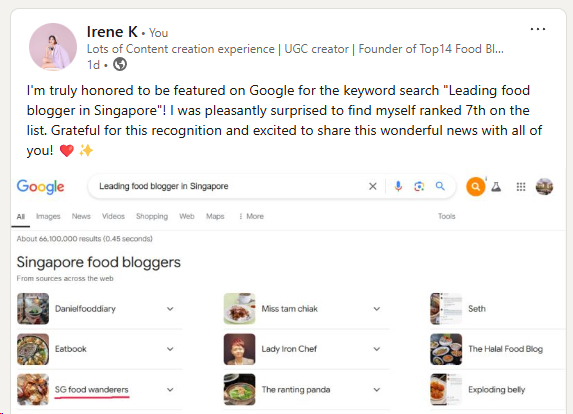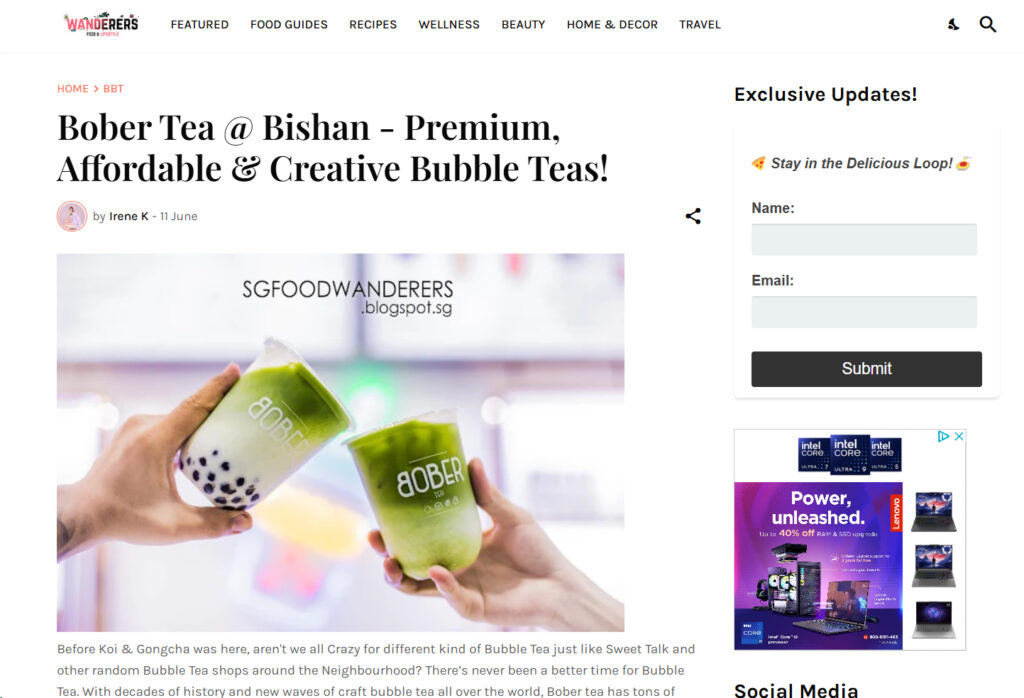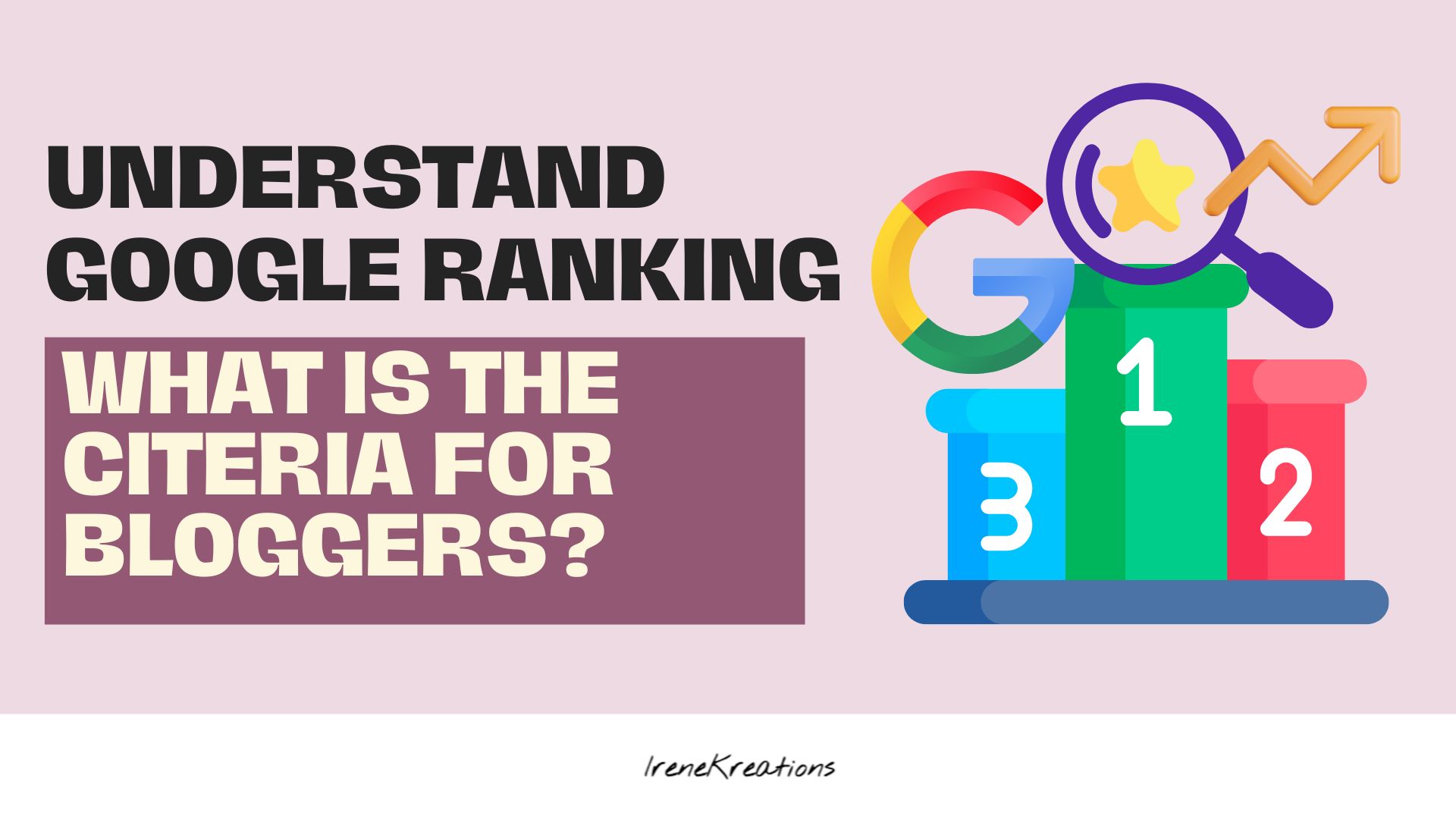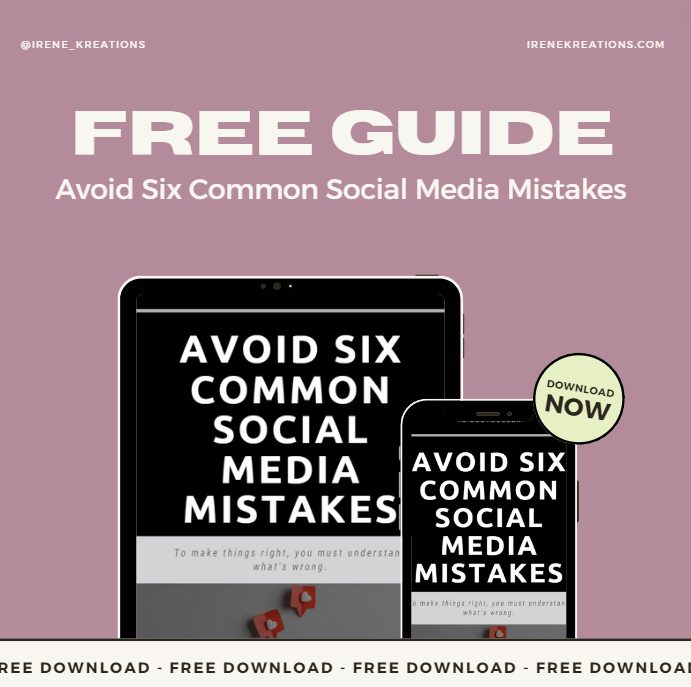You may have come across my post on LinkedIn and Telegram channel! I was casually searching for the keyword “Leading food blogger in Singapore” on Google and was pleasantly surprised to see myself ranked 7th on the list. Over the years, I’ve been featured as one of the Top Food Bloggers across multiple media platforms, usually ranking beyond the 10th position. So seeing a 7th-place ranking—even if it’s just in Google search results—definitely made my day!

That got me thinking and inspired me to write this article. If you’ve ever wondered what determines a blogger’s ranking—why some make the list while others don’t—what exactly is it based on?
I’m genuinely proud of how far I’ve come, and it’s not just about claiming recognition with words. It takes real effort to get there. And the good news? You can do it too.
Google’s ranking criteria involve a complex algorithm that considers multiple factors to determine the relevance and usefulness of a webpage. Here are some key factors:
1. Keyword Relevance
Google’s primary goal is to provide users with the most relevant search results. This means that content must align closely with what people are searching for. Using well-researched keywords strategically within your content, headings, and metadata increases the likelihood of ranking higher. However, keyword stuffing (overloading content with keywords unnaturally) can negatively impact rankings.
2. Content Quality
High-quality content is a major ranking factor. Google favors articles that are well-researched, informative, engaging, and original. Content that provides real value to readers—whether through detailed explanations, step-by-step guides, or unique insights—tends to rank better. Consistency also matters, as blogs that regularly publish fresh and useful content are seen as more authoritative.

I used to carry my big, bulky DSLR everywhere when I went cafe-hops and trying food adventure. It does give me high-quality photos, and with my background as a professional photographer at that time, my blog was filled with visually appealing shots from the start. But a few years ago, I switched to using my smartphone instead—and it’s still ranking high, getting closer and closer to the top each year. Wondering why? Keep reading…
3. Page Authority & Trustworthiness
Google assesses a website’s authority based on factors like domain age, the credibility of sources, and past user interactions. Websites that have been around longer, have high engagement, and offer accurate, factual information gain more trust. This is why many high-ranking bloggers spend years building a solid reputation.
4. Link Equity (Backlinks & Internal Links)
Backlinks—links from other credible websites pointing to your blog—are one of the strongest ranking signals. When authoritative sites link to your content, it tells Google that your page is valuable and trustworthy. Internal linking (linking between pages on your website) also helps distribute link equity and keeps users engaged on your site longer.
I realized along the way that being featured (earned media) is also a fantastic backlink.
5. User Experience (UX) & Mobile Friendliness
A website’s design, speed, and mobile compatibility all contribute to its ranking. Since most users browse on mobile devices, Google prioritizes mobile-friendly sites with fast loading times and intuitive navigation. A cluttered or slow website can lead to higher bounce rates, negatively affecting rankings. And yes, I invest in a professional web designer to revamp my blog design and layout every few years, ensuring it stays modern, visually appealing, and optimized for the best user experience.
If you’re curious, you can track how users land on your page, how they scroll, what they read, what they click, and how they exit your website using Hotjar. This insight will help you make improvements to enhance the user experience for your readers.
6. Technical SEO (On-Page Optimization)
Properly optimizing meta tags, title tags, headers, and image alt text makes it easier for search engines to understand and index your content. A well-structured website with a logical URL hierarchy also improves crawlability, which helps boost rankings.
7. Local SEO (For Location-Based Searches)
If your blog targets a specific region (e.g., “Best Cafés in Singapore”), Google uses location-based signals to rank your content accordingly. Claiming your business on Google My Business, including local keywords, and getting reviews from local users can enhance visibility in location-based searches.

8. Content Freshness & Updates
Google prefers fresh, up-to-date content, especially for topics that change frequently (e.g., food trends, travel guides). Updating old posts, adding new insights, and republishing evergreen content can help maintain rankings over time.
I also make sure to update old posts with relevant information. For every food place I’ve visited that has closed down after a few years, I don’t delete the posts. Instead, I update it to say “[closed]” so my readers won’t show up at the restaurant that doesn’t exist anymore, disappointed and cursing, haha.
9. Social Signals (Engagement & Shares)
While social media presence doesn’t directly influence rankings, engagement metrics—such as shares, likes, and comments—signal that content is valuable. If a blog post goes viral or receives high engagement, it can lead to more backlinks and increased traffic, indirectly improving search rankings. Secondly, although Social media isn’t the main factor that gets you to the top on Google ranking, but it does help Google recognize that you exist and you’re a person/brand that is active online. For your own benefit, a strong brand presence on social media can spark curiosity in your audience, prompting them to search for you—and that, in turn, boosts your Google ranking too.
10. Google RankBrain (AI-Driven Ranking Adjustments)
RankBrain, Google’s machine learning algorithm, continuously evaluates user behavior. If users frequently click on a webpage, stay engaged, and interact with it, RankBrain interprets it as high-value content. The algorithm adapts search rankings accordingly based on real-time user interactions.
Final Thoughts: How You Can Improve Your Blog’s Ranking
Ranking on Google isn’t just about luck—it requires effort, strategy, and persistence. By focusing on these key ranking factors, you can improve your blog’s visibility and authority over time. These factors constantly evolve, and Google’s algorithm updates aim to improve search results’ accuracy and relevance.
I definitely didn’t have all this knowledge from day one of my food blogging journey. It’s been a process of building skills and learning along the way. What I did focus on from the start, though, was high-quality photos (which I pretty much mind) and well-researched, authentic content—stuff you won’t easily find elsewhere on the internet. And of course, consistency. I’ve never stopped posting for the past 10 years.
One piece of bonus advice for anyone starting out as a content creator or blogger: don’t hold back when sharing your experiences or reviewing brands you’ve tried. I know many content creators who focus on getting paid for every post per platform but trust me—it’s more than just the money. Sometimes, sharing your genuine experience can benefit you far more than any brand partnership. When you’re authentic and true to your story, that’s when recognition follows, and it ultimately benefits the brand too. It’s not about how much they’re paying you; it’s about being unique and sharing the experiences you truly love. Stay true to yourself, and the money will follow.
Having said that, being a blogger/content creator today is so different from 10 years ago. Back then, we literally had to dig through the fog for inspiration. Now, there are so many platforms, like social media and AI tools, that can spark amazing ideas. And the best part? It can still be completely authentic if it’s rooted in your own experiences and thoughts. Sometimes, all it takes is a little guidance to refine those ideas. Plus point, it’s really efficient too.
Speaking of which, if you want your content to stand out and avoid feeling like a copy of the same thing from somebody’s else ChatGPT, you might want to explore AI-powered engineered prompts. These prompts don’t just spit out answers—they at times, actually ask you questions that help you drive greater detailed answers, pulling out the most meaningful and accurate insights.
And if that sounds a bit difficult, I’ve got something that could help: my Engineered AI prompt CHEATBOOK. With 117 tailored prompts and step-by-step instructions, it’s designed to help you harness the full potential of AI and enhance your content with ease.
✧⭒✦✧⭒✦◇◇◇✦⭒✧✦⭒✧
So, well, Ready to Maximize Your Productivity? With over 117 AI prompts at your disposal, the E-CHEATBOOK is designed to help you get results fast—without needing to be an expert. From social media posts to SEO articles and ad campaigns, this e-book is your key to unlocking the full potential of AI in your business.
If you’re ready to take your productivity to the next level and grow your business faster, get your copy of the E-CHEATBOOK today!

✧⭒✦✧⭒✦◇◇◇✦⭒✧✦⭒✧








